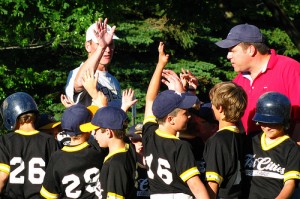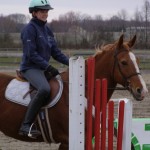by Michelle Sutton-Kerchner
Unintentional injury, occasionally severe, is common among children. By following some fitness smarts, kids can be safely active—even without that bubble you’ve been building for them …
Outdoor sports are well underway, making April the ideal time for National Youth Sports Safety month. Just as with adults, kids who participate in sports are prone to the occasional injury. Consider it part of the initiation process. Adults may take twice as long to heal. However, children may ignore their limitations (from that attitude of invincibility that triggers them to do some of life’s crazier things).
Get Them at the Top of Their Game
A fit, strong body is the ideal one to send onto the playing field, whether a young, fresh athlete or a veteran. Those who exercise prior to joining sports tend to have better balance, coordination, and confidence in their physical abilities. Sport-specific training can prepare the body for the requirements of different athletics.

On a basic level, cardio and strengthening of any sort can make a star player. Cross training is useful; it works many areas of the body for overall conditioning. Starting sports in healthy condition is proven to prevent overuse injuries like stress fractures and torn ligaments.
It’s not a secret that football players have long practiced ballet exercises to develop skills like balance. You may struggle to get your wrestler to do barre work (even some who love dance find it a chore). However, there are a variety of exercises that enhance focus while improving balance and strength.
Yoga can be practiced at any age. Perhaps try a Yoga class yourself and share some of the basic moves with your tot. There are also specific yoga exercises for children, complete with fun names like Warrior and Sphinx. (Check out The ABCs of Yoga for Kids by Teresa Anne Power (Scholastic Inc.) at www.barnesandnoble.com or other booksellers.
The Center’s FitKids program offers Yoga classes for ages six years and older, as well as Rebounding and Cycle classes. Part of the class focuses on how these types of exercises enhance other activities through their cross-training function. Yoga improves balance and focus, Rebounding promotes cardio strength with its interval work, and Cycle increases overall strength and cardio.
Kids from ages two to five thrive in the FitKids toddler programs. Promoting self-esteem and a lifelong love of exercise is the main goal. “So often I hear ‘I can’t do that’ from the kids. I tell them to try it just once and then flood them with praise,” shares FitKids Coordinator Kristen Mains. Throughout, Kristen feeds positive reinforcement to the children. The emphasis is on trying and expending effort.
“I would love to see more parents take advantage of the FitKids program, if for no other reason than promoting a lifelong love of movement,” shares Kristen. “Exercise has no downside. It helps kids sleep better at night, focus better in school, build self-esteem, and boost their immune systems to help fight off colds and other sickness.” She adds, “It is fun, and it is social. What could be better than that?”

Fourteen-year-old member Angelica Franco says her time at the Center keeps her in the best shape. “The Center has helped me succeed in all my sports, especially tennis, my favorite,” she says with pride. Angelica exercises daily at the Center. She devotes her life to exercise, both to be fit and play hard. “People call me crazy, but I call myself smart.” The proof is in her game.
The American Orthopedic Society for Sports Medicine publishes useful injury-prevention tip sheets for a variety of sports and activities. They provide insight on injuries common to specific sports, along with recommendations like play time and rest time based on age. Become familiar with these. Follow the advice given by experts. Perhaps share it with coaches and trainers. It can help create a game plan to execute both on and off the field.
Scouting Out Your Options
Consider yourself as your child’s agent. Without you to advocate on his/her behalf, often no one will. If the coach seems unqualified or the league’s schedule is unreasonable, investigate other options. Most organizations follow standard requirements for youth sports. Make sure your community plays fair:
- All coaches should have first aid training.
- There should be written policies on procedures for dealing with injuries and illnesses. The coach should have multiple methods of reaching you should such emergencies occur.
- Water should be available at all games and practices. Hydration should be continuously encouraged. Kids often get caught up in game play and forget to hydrate.
- Is safety equipment frequently checked and always utilized? The “easy coach” who lets these items slide often has some tough challenges as a result.
- Are all children given an opportunity to shine? Balancing play time and bench time fosters a healthy attitude and a healthy team. Sure, some kids will excel and others will be giving their own version of best. You don’t want overuse to injure your top players—or underuse to injure the mediocre.
- Adequate warm-up and cool-down periods should be provided where the team comes together for a good stretch session and maybe even a pep talk or two.
Before Sign-Up
Good physical condition is essential. You and your child are aware of his/her stamina and skill levels. But, you can’t always evaluate what occurs beneath the surface. Be sure your child undergoes a complete physical with the pediatrician prior to joining any sports. Upon registering, proof of a recent physical is usually mandatory.
This physical, and the required paperwork, should be taken seriously. The nationally publicized recent deaths of two youths have many fearing undetected heart issues in young athletes. According to an article in the journal Circulation, more than half of sudden deaths in young athletes are a result of underlying heart disease. There are more than 30 identified causes of sudden death in athletes.
If your child has a risk factor, know it. Inform your pediatrician of any genetic predisposition (including hypertrophic cardiomyopathy), history of asthma, or symptoms. Additional testing, such as an EKG, may be required before engaging in physical activities.
About Concussions

Become familiar with the signs of this common and serious injury. A concussion may result from the most unsuspecting events. An avid horseback rider could go through lessons unscathed, only to have a random pile of textbooks fall from a top locker and cause a concussion. (A true tale.) Recognizing the symptoms of this injury can save a life, in sports or in the library!
If a concussion is suspected, stop activity immediately and head straight to a physician. If the situation is critical, go to the nearest hospital’s emergency room.
Watch for:
- Headache (usually lasts for at least two hours)
- Nausea and/or vomiting
- Dizziness or trouble with balance
- Blurred or double vision
- Sensitivity to light, sound, and/or noise
- Drowsiness
- Excessive sleepiness or trouble sleeping
- Trouble concentrating; feeling “foggy”
- Forgetfulness
- Clumsiness
- Dazed
- Emotional
(If your child is a teen, that last sign may not be an accurate determiner.)
A physician will perform a series of routine tests on your child to conclude a concussion diagnosis. An eye exam may be included. If the diagnosis is positive, your child will need a leave of absence from contact sports with other physical activities limited. You’ll need to practice extreme caution so s/he doesn’t get a double concussion.
Have Fun
Emphasize the true meaning of sports and fitness. You are your child’s first role-model. By making exercise a priority and living the healthiest life possible, you’re making a clear, powerful statement to kids. Demonstrate good sportsmanship at all times. Use losses or misses as an opportunity for learning and reassurance.
And, before you begin your quest to grow the next soccer champion, be sure your child understands and enjoys the game. Does s/he want to play? Or, is this your lost youth fighting for another chance to score the winning point? Fate has a way of giving the high school quarterback of yesteryear a mini pianist.
Sources
“Concussions–Symptoms and Signs,” by Catherine Holecko at www.about.com.
“Kid Safety and Sports: Keep Kids Safe from Injuries,” by Robin McClure at www.about.com.
“National Youth Sports Safety Month,” by Catherine Holecko at www.about.com.
“Youth Sports Safety Tips for Parents,” by Elizabeth Quinn at www.about.com.
“7 Ways to Protect Your Young Athlete from Sudden Cardiac Death,” by Cynthia Ramnarace at www.everydayhealth.com.
Image Credits
High-fives: www.flickr.com/photos/psycho-pics/2630163338/
 Fitness & Wellness News Your Source for Fitness News, Wellness News, Health News, and Nutrition News!
Fitness & Wellness News Your Source for Fitness News, Wellness News, Health News, and Nutrition News!



